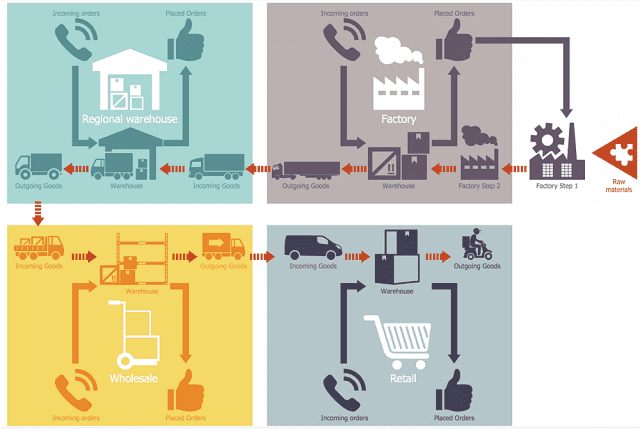
Supply Chain Management is based on certain activities and processes that are important when it comes to making a product. If such steps can’t be taken seriously then the process would fail and there would be a lack of that product in regard to supplying.
This management is known as the active management of the activities related to the supply chain for the sake of maximizing customer value and attains a maintainable competitive advantage. It signifies a mindful effort by the companies to grow and run supplies in the most operative & efficient ways possible. These activities deal everything from product development, tracing, production, and logistics, as and the information systems required when it comes to coordinate such activities.
The notion of Supply Chain Management depends on two central ideas that are the following:
1. The former is that nearly every product that attains an end user characterizes the increasing effort of numerous organizations. These organizations are denoted to collectively as the supply chain.
2. The latter notion is that although this management has existed on its own for a long time now, most corporations only concentrated on the idea of what was occurring within their “four walls.” There were few trades understood, much less accomplished, the whole chain of activities that eventually transported products to the final purchaser. The consequence was rambling and mostly unsuccessful supplies.
SCM Flows

In case the goal of SCM is to offer high product accessibility via effectual and well-timed contentment of purchaser demand, then how is the goal attained?
Clearly, you should have operative flows of products from the point of source to the point of depletion. But there’s much more to it. Think about the picture of the fresh food supplies. Here a two-way flow of info and data among the supply chain members makes perceptibility of request and fast detection of complications. Both are required by managers, so they could right decisions concerning what to purchase, make, and move.
Other flows are also significant. In their parts as suppliers, corporations have a devolved interest in monetary flows; suppliers need to get paid for their products and services as soon as possible and with least annoyance. At times, it is also essential to move products back for returns, maintenances, reprocessing, or removal.
Because of all the procedures that have to take place at various kinds of contributing companies, each corporation requires supply chain managers to support in improving their flows of product, info, and cash. This opens new horizons of a prospect to you so you could gain profit from an extensive variety of SCM career options. You may click this website to explore more career options here.
SCM Processes

It can be said that SC activities aren’t the concern of one person or one corporation. There are many people who are supposed to be keenly involved in a number of various courses to make it work.
You can say that it’s kind of like baseball. Though all the members are named baseball players, they don’t do whatsoever they want. Everyone has a role, someone is a pitcher, someone else a catcher, shortstop, etc. and must perform well at their allotted duties like fielding, throwing, or hitting for the whole team to be effective.
Without any doubt, these players have to work well together. A hit-and-run play will only be fruitful in case the base runner gets the signal and takes off running, although the batter makes real contact with the ball. The team also requires a manager to change a game plan, put people in the right situations, and observe attainment.
Same in the case with winning the SCM “game” that needs supply chain specialists to play parallel roles. Every SC player must comprehend his or her role, advance winning policies, and cooperate with their SC partners. By following this pattern, the SCM team can impeccably perform the following courses:
Planning

The planning process tries to find to operate long- and short-range supply approaches. Starting from the scheme of this chain network to the expectation of customer demand, supply chain frontrunners are supposed to develop united supply chain approaches.
Procurement
The buying process stresses on the purchase of essential raw materials, modules, and goods. As a customer, you would probably acquaint with buying stuff.
Production

The make procedure comprises the manufacture, adaptation, or meeting of materials into finished merchandises or parts for other products. SC managers give production aid and make it sure that the main materials are accessible when required.
Distribution
The moving procedure copes with the logistical flow of merchandises across the supply chain. Here transportation corporations, third-party logistics businesses, and others safeguard that goods are rolling rapidly and securely toward the point of demand.
Consumer Interface

The course of demand revolves around all the problems that are interlinked to planning communications with customers, nourishing their needs, and accomplishing orders impeccably.
Principles of SCM
Following are 7 main principles of SCM:
1. Segment consumers based on the service requires of dissimilar groups and familiarize the supply chain to serve these parts cost-effectively.
2. Modify the logistics network according to the necessities and effectiveness of customer segments.
3. Concentrate on market signals and bring into line demand planning consequently across the supply chain, making sure reliable forecasts and ideal resource provision.
4. Distinguish product closer to the consumer and speed conversation across the SC.
5. Manage the bases of supply tactically to decrease the total cost of retaining supplies and services.
6. Advance a supply chain-wide technology plan that aids different stages of decision making and gives a clear outlook of the flow of products, services, and evidence.
7. Approve channel-spanning performance that processes to device cooperative achievement in attaining the end-user efficiently and competently.

For the sake of applying successful business plans, corporations should work diligently towards a common goal that would be beneficial for everyone.








